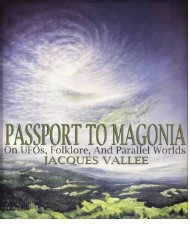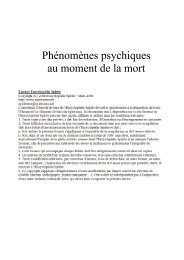extraordinary%20encounters
extraordinary%20encounters
extraordinary%20encounters
Create successful ePaper yourself
Turn your PDF publications into a flip-book with our unique Google optimized e-Paper software.
162 Marian apparitions<br />
that these experiences were purely hallucinatory;<br />
he was convinced of an underlying but<br />
impenetrable reality forever disguised under<br />
many masks. A British magazine, still published,<br />
named itself Magonia after Vallee’s<br />
book, though the magazine rejects paranormal<br />
explanations of such phenomena.<br />
The Magonia story appeared originally in a<br />
circa 833 manuscript written in Latin by Agobard<br />
(779–840), the Archbishop of Lyons.<br />
The title in English is “Book Against False<br />
Opinions Concerning Hail and Thunder.”<br />
Agobard was fiercely hostile to all non-Christian<br />
beliefs. One that particularly infuriated<br />
him was the “mad and blind” belief that<br />
“there exists a certain region called Magonia,<br />
from which ships, navigating on clouds, set<br />
sail to transport back to this same region the<br />
fruits of the earth ruined by hail and destroyed<br />
by the storm.” Agobard tells of “several<br />
of these senseless fools” who held in custody<br />
“three men and one woman, who they<br />
said had fallen from these ships.” The prisoners<br />
were brought in front of an assembly to be<br />
stoned to death, but the archbishop managed<br />
to save their lives, after “the truth finally triumphed”<br />
and he had shown up the absurdity<br />
of the charges (Brodu, 1995).<br />
In a critical analysis of the legend, French<br />
anomalist Jean-Louis Brodu reviewed Magonia’s<br />
various uses over the centuries as well as<br />
the embellishments that attached themselves<br />
to it. In the UFO age, the sketchy account<br />
was variously represented as a landing with<br />
aliens or an early abduction case. Some accounts<br />
twisted details and reported that the<br />
captives had been stoned to death, Agobard’s<br />
explicit words to the contrary. Surveying the<br />
scholarly literature on the Magonian tales,<br />
Brodu argues that Agobard’s account makes<br />
no sense outside the context of the period,<br />
which included the belief that the Earth is flat<br />
and that ships can sail through cloud seas.<br />
“Magonia” may be a corruption of “Magonianus,”<br />
meaning “from Port-Mahon,” a onceflourishing<br />
harbor on the Balearic island of<br />
Minorca.<br />
See Also: Abductions by UFOs; Fairies encountered<br />
Further Reading<br />
Brodu, Jean-Louis, 1995. “Magonia: A Re-evaluation.”<br />
In Steve Moore, ed. Fortean Studies: Volume<br />
2, 198–215. London: John Brown Publishing.<br />
Drake, W. R., 1964. “Spacemen in the Middle<br />
Ages.” Flying Saucer Review10, 3 (May/June):<br />
11–13.<br />
Vallee, Jacques, 1969. Passport to Magonia: From<br />
Folklore to Flying Saucers. Chicago: Henry Regnery<br />
Company.<br />
Marian apparitions<br />
Visions of the Blessed Virgin Mary (BVM)<br />
have been reported since at least the third century<br />
of the Christian era. The first for which<br />
there is anything approximating detailed<br />
knowledge dates back to 1061 when the BVM<br />
provided a vision of Christ’s residence in<br />
Nazareth and directed the witness, the lady of<br />
the manor in Walsingham, Norfolk, to see<br />
that a precise copy was constructed on the<br />
spot. A few visions are well known, and the<br />
Roman Catholic Church has granted official<br />
recognition to a small number, though it has<br />
rejected the vast majority as delusional. BVM<br />
encounters are far from rare. Every year several<br />
occur around the world. With very few<br />
exceptions, the primary witnesses are<br />
Catholics, and usually devout followers of the<br />
faith. Sometimes other supernatural phenomena<br />
accompany the BVM’s manifestation and<br />
become, to the faithful, veridical evidence that<br />
the event was real.<br />
Undoubtedly the most spectacular such<br />
case took place in Fatima, Portugal, in 1917.<br />
The incident is extraordinarily complicated.<br />
What follows is a highly abbreviated account.<br />
Around noon on May 13, three children,<br />
two girls and a boy, tending sheep, saw a flash<br />
of light and observed a brilliantly illuminated<br />
figure of a woman standing amid the branches<br />
of an oak tree. The apparition announced that<br />
she was from heaven and would return six<br />
times, on each occasion on the thirteenth of<br />
each succeeding month. On the last visitation<br />
in October, she would tell them who she was<br />
and why she had come. Soon word spread,<br />
and by June 13 some sixty persons accompa-





